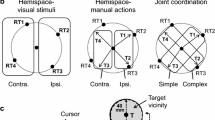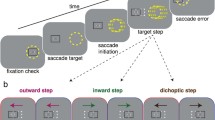Summary
The processes which develop to coordinate eye and hand movements in response to motion of a visual target were studied in young children and adults. We have shown that functional maturation of the coordination control between eye and hand takes place as a result of training. We observed, in the trained child and in the adult, that when the hand is used either as a target or to track a visual target, the dynamic characteristics of the smooth pursuit system are markedly improved: the eye to target delay is decreased from 150 ms in eye alone tracking to 30 ms, and smooth pursuit maximum velocity is increased by 100%. Coordination signals between arm and eye motor systems may be responsible for smooth pursuit eye movements which occur during self-tracking of hand or finger in darkness. These signals may also account for the higher velocity smooth pursuit eye movements and the shortened tracking delay when the hand is used as a target, as well as for the synkinetic eye-arm motions observed at the early stage of oculo-manual tracking training in children. We propose a model to describe the interaction which develops between two systems involved in the execution of a common sensorimotor task. The model applies to the visuo-oculo-manual tracking system, but it may be generalized to other coordinated systems. According to our definition, coordination control results from the reciprocal transfer of sensory and motor information between two or more systems involved in the execution of single, goal-directed or conjugate actions. This control, originating in one or more highly specialized structures of the central nervous system, combines with the control processes normally operating in each system. Our model relies on two essential notions which describe the dynamic and static aspects of coordination control: timing and mutual coupling.
Similar content being viewed by others
References
Barmack NH (1970) Dynamic visual acuity as an index of eye movement control. Vision Res 10: 1377–1391
Buizza A, Schmid R (1986) Velocity characteristics of smooth pursuit eye movements to different patterns of target motion. Exp Brain Res 63: 395–401
Fischer B, Ramsperger E (1984) Human express-saccades: extremely short reaction times of goal-directed eye movements. Exp Brain Res 57: 191–195
Gauthier GM, Hofferer JM (1976) Eye tracking of self-moved targets in the absence of vision. Exp Brain Res 26: 121–139
Gauthier GM, Hofferer JM, Mussa-Ivaldi F (1981) Etude des troubles oculomoteurs affectant certains enfants infirmes moteurs cérébraux: semiologie instrumentale et possibilités de rééducation. Ann Med Physique 24: 64–76
Gauthier GM, Mussa Ivaldi F (1988) Oculo-manual tracking of visual targets in monkey: role of the arm afferent information in the control of arm and eye movements. Exp Brain Res 73: 138–154
Gauthier GM, Voile M (1975) Two dimensional eye movement monitor for clinical and laboratory recordings. EEG Clin Neurophysiol 39: 285–291
Gielen CCAM, Van den Heuven PJM, Van Gisberger JAM (1984) Coordination of fast eye and arm movements in a tracking task. Exp Brain Res 56: 154–161
Howard IP (1982) Adaptation to discordant stimulation. In: Human visual orientation. John Wiley and Sons, New York, pp 480–520
Lackner JR, Levine MS (1978) Visual direction depends on the operation of spatial constancy mechanisms: the oculobrachial illusion. Neurosci Lett 7: 207–212
Levine MS, Lackner JR (1979) Some sensory and motor factors influencing the control and appreciation of eye and limb position. Exp Brain Res 36: 275–283
Mather JA, Lackner JR (1980) Multiples sensory and motor cues enhance the accuracy of pursuit eye movements. Aviat Space Env Med 51: 856–859
Mather JA, Lackner JR (1981) The influence of afferent proprioceptive and timing factors on the accuracy of eye-hand tracking. Exp Brain Res 43: 406–412
Meyer GH, Lasker AG, Robinson DA (1985) The upper limit of human smooth pursuit velocity. Vision Res 25: 561–563
Piaget J (1936) La naissance de l'intelligence chez l'enfant. Del et Niestle, eds. pp 1–426
Prablanc C, Jeannerod M (1973) Continuous recording of hand position in the study of complex visuo-motor tasks. Neurophysiology 11: 123–125
Prablanc C, Echallier JF, Komilis E, Jeannerod M (1979) Optimal response of eye and hand motor systems in pointing at a visual target. Biol Cybern 35: 113–124
Robinson DA (1965) The mechanisms of human smooth pursuit eye movement. J Physiol (London) 180: 569–591
Schalen L, Henriksson NG, Pyykko I (1982) Quantification of tracking eye movements in patients with neurological disorders. Acta Otolaryngol 93: 387–395
Stark L, Vossius G, Young LR (1962) Predictive control of eye tracking movements. IEEE Trans Human Factors Electron 3: 52–57
Steinbach MJ, Held R (1968) Eye tracking of observer-generated target movements. Science 161: 187–188
Steinbach MJ (1969) Eye tracking of self-moved targets: the role of efference. J Exp Psychol 82: 366–376
Vercher JL, Gauthier GM (1988) Cerebellar involvement in the coordination control of the oculo-manual tracking system: effect of cerebellar dentate nucleus lesion. Exp Brain Res 73: 155–166
Westheimer G (1954a) Mechanism of saccadic eye movements. AMA Arch Ophthalmol 52: 710–724
Westheimer G (1954b) Eye movement responses to a horizontally moving visual stimulus. Arch Ophthalmol 52: 932–941
White BL, Held R (1967) Plasticity of sensorimotor development in the human infant. In: Mellmuth J (ed) The experimental infant, Vol 1. Special Child Publications, Seattle
Author information
Authors and Affiliations
Rights and permissions
About this article
Cite this article
Gauthier, G.M., Vercher, J.L., Mussa Ivaldi, F. et al. Oculo-manual tracking of visual targets: control learning, coordination control and coordination model. Exp Brain Res 73, 127–137 (1988). https://doi.org/10.1007/BF00279667
Received:
Accepted:
Issue Date:
DOI: https://doi.org/10.1007/BF00279667




